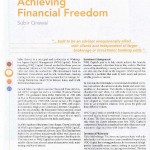Al Gore’s SRI Investment Fund To Focus On Asia

Earlier this week, Bloomberg ran a story about the rumored creation of a $500 million investment fund to be launched by Generation Investment Management, the socially responsible investment firm co-founded by Al Gore. If true (which seems to be the case since Generation has not publicly denied the story), it would be the single largest investment fund to target Asia with a socially responsible mandate.
Generation Investment Management, which Gore co-founded in 2004 with David Blood, a former head of asset management at Goldman Sachs, is headquartered in London with offices in New York and Sydney.Over the past several years, they have quickly emerged as a major player in the socially responsible investment space.In 2008, they closed their flagship Global Equity Fund to new investors after successfully raising $5 billion dollars in assets.This strategy invests in a concentrated portfolio (approximately 30-50 individual positions at any given time) of publicly traded global companies.
In 2007, Generation launched a second strategy, the Climate Solutions Fund, which is more of a pure play into the green energy space. The fund targets both public and private equity opportunities, focusing almost exclusively on small cap energy companies engaged in helping the world transition from a high-carbon to a low carbon economy. According to the website, this fund has selected four main sectors within the alternative energy space for investment: renewable energy generation and distribution, energy efficiency and demand destruction, carbon markets and climate-related financial services, and solutions for the biomass economy.This fund also was also closed in 2008 after successfully raising $683 million in capital from investors.
The Asia Fund, like the Global Equity and Climate Solutions funds before it, will likely follow a strict investment philosophy mandate that integrates sustainability research into a rigorous traditional investment process in order to deliver superior long-term results.Like several other socially responsible investment managers in the space, Generation subscribes to the view that companies which effectively confront sustainability factors now will outperform those companies which do not, particularly in the long term.
While performance data for the funds is not publicly disclosed, according to Bloomberg, in an annual report filed by one of Generation’s institutional investors, the UK Environment Agency’s pension fund, the Global Equities fund outpaced its benchmark index (the MSCI World Index) by 10% in the 12 month period ending in March 2010.This data, while certainly a small sample size, is particularly impressive given the fact that the index was up 47% over the same period.
So how does one invest in Generation’s Funds?
Currently, their funds are closed to new money and are only available to institutional and/or high net worth investors. It remains to be seen whether or not Generation decides to open up their strategies to smaller investors through a mutual fund offering. If they do decide to go in this direction, it’s safe to say their prospects certainly won’t be hurt by having the world’s foremost SRI pitch man in their corner.
Image Credit: Tom Raftery
This article originally appeared on Just Means.






